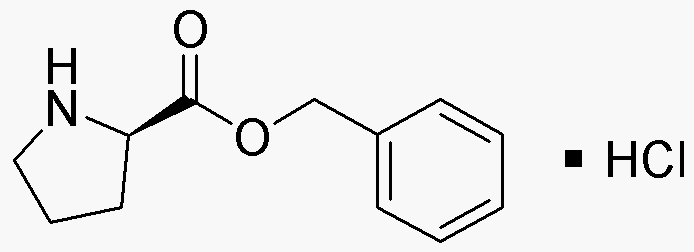D-Proline benzyl ester hydrochloride is widely utilized in research focused on:
- Peptide Synthesis: This compound serves as a valuable building block in the synthesis of peptides, particularly in creating cyclic peptides that have enhanced stability and bioactivity.
- Pharmaceutical Development: It is used in the development of pharmaceutical compounds, especially those targeting neurological disorders, due to its ability to mimic natural amino acids.
- Biochemical Research: Researchers leverage this chemical in studies involving protein folding and enzyme activity, helping to elucidate mechanisms of action in biological systems.
- Cosmetic Formulations: The compound is incorporated into cosmetic products for its moisturizing properties, enhancing skin hydration and texture.
- Food Industry: It finds applications in flavor enhancement, where it can be used to develop novel food additives that improve taste profiles.
General Information
Properties
Safety and Regulations
Applications
D-Proline benzyl ester hydrochloride is widely utilized in research focused on:
- Peptide Synthesis: This compound serves as a valuable building block in the synthesis of peptides, particularly in creating cyclic peptides that have enhanced stability and bioactivity.
- Pharmaceutical Development: It is used in the development of pharmaceutical compounds, especially those targeting neurological disorders, due to its ability to mimic natural amino acids.
- Biochemical Research: Researchers leverage this chemical in studies involving protein folding and enzyme activity, helping to elucidate mechanisms of action in biological systems.
- Cosmetic Formulations: The compound is incorporated into cosmetic products for its moisturizing properties, enhancing skin hydration and texture.
- Food Industry: It finds applications in flavor enhancement, where it can be used to develop novel food additives that improve taste profiles.
Documents
Safety Data Sheets (SDS)
The SDS provides comprehensive safety information on handling, storage, and disposal of the product.
Product Specification (PS)
The PS provides a comprehensive breakdown of the product’s properties, including chemical composition, physical state, purity, and storage requirements. It also details acceptable quality ranges and the product's intended applications.
Certificates of Analysis (COA)
Search for Certificates of Analysis (COA) by entering the products Lot Number. Lot and Batch Numbers can be found on a product’s label following the words ‘Lot’ or ‘Batch’.
*Catalog Number
*Lot Number
Certificates Of Origin (COO)
This COO confirms the country where the product was manufactured, and also details the materials and components used in it and whether it is derived from natural, synthetic, or other specific sources. This certificate may be required for customs, trade, and regulatory compliance.
*Catalog Number
*Lot Number
Safety Data Sheets (SDS)
The SDS provides comprehensive safety information on handling, storage, and disposal of the product.
DownloadProduct Specification (PS)
The PS provides a comprehensive breakdown of the product’s properties, including chemical composition, physical state, purity, and storage requirements. It also details acceptable quality ranges and the product's intended applications.
DownloadCertificates of Analysis (COA)
Search for Certificates of Analysis (COA) by entering the products Lot Number. Lot and Batch Numbers can be found on a product’s label following the words ‘Lot’ or ‘Batch’.
*Catalog Number
*Lot Number
Certificates Of Origin (COO)
This COO confirms the country where the product was manufactured, and also details the materials and components used in it and whether it is derived from natural, synthetic, or other specific sources. This certificate may be required for customs, trade, and regulatory compliance.

